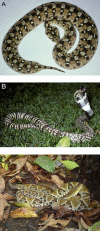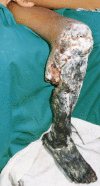Confronting the neglected problem of snake bite envenoming: the need for a global partnership
- PMID: 16729843
- PMCID: PMC1472552
- DOI: 10.1371/journal.pmed.0030150
Confronting the neglected problem of snake bite envenoming: the need for a global partnership
Abstract
Envenoming resulting from snake bites is an important public health hazard in many regions of the world, yet public health authorities have given little attention to the problem.
Conflict of interest statement
Figures



Comment in
-
Snakebite: sociocultural anthropological bias.PLoS Med. 2006 Sep;3(9):e412. doi: 10.1371/journal.pmed.0030412. PLoS Med. 2006. PMID: 17002512 Free PMC article. No abstract available.
Similar articles
-
[Global incidence of snake and scorpion envenoming].Med Sci (Paris). 2009 Feb;25(2):197-200. doi: 10.1051/medsci/2009252197. Med Sci (Paris). 2009. PMID: 19239853 French.
-
[Snake serum becoming scarce. The churches also issue warning].MMW Fortschr Med. 2002 Oct 3;144(40):15. MMW Fortschr Med. 2002. PMID: 12440287 German. No abstract available.
-
Reducing the impact of snakebite envenoming in Latin America and the Caribbean: achievements and challenges ahead.Trans R Soc Trop Med Hyg. 2014 Sep;108(9):530-7. doi: 10.1093/trstmh/tru102. Epub 2014 Aug 5. Trans R Soc Trop Med Hyg. 2014. PMID: 25096295 Review.
-
Snakebite envenoming from a global perspective: Towards an integrated approach.Toxicon. 2010 Dec 15;56(7):1223-35. doi: 10.1016/j.toxicon.2009.11.020. Epub 2009 Nov 29. Toxicon. 2010. PMID: 19951718 Review.
-
The anti snake venom crisis in Africa: a suggested manufacturers product guide.Wilderness Environ Med. 2009 Fall;20(3):275-82. doi: 10.1580/08-WEME-CON-296R1.1. Wilderness Environ Med. 2009. PMID: 19737031
Cited by
-
Snakebite and its socio-economic impact on the rural population of Tamil Nadu, India.PLoS One. 2013 Nov 21;8(11):e80090. doi: 10.1371/journal.pone.0080090. eCollection 2013. PLoS One. 2013. PMID: 24278244 Free PMC article.
-
Current challenges for confronting the public health problem of snakebite envenoming in Central America.J Venom Anim Toxins Incl Trop Dis. 2014 Mar 6;20(1):7. doi: 10.1186/1678-9199-20-7. J Venom Anim Toxins Incl Trop Dis. 2014. PMID: 24602234 Free PMC article.
-
Snakebites are associated with poverty, weather fluctuations, and El Niño.Sci Adv. 2015 Sep 11;1(8):e1500249. doi: 10.1126/sciadv.1500249. eCollection 2015 Sep. Sci Adv. 2015. PMID: 26601254 Free PMC article.
-
Assessing SABU (Serum Anti Bisa Ular), the sole Indonesian antivenom: A proteomic analysis and neutralization efficacy study.Sci Rep. 2016 Nov 21;6:37299. doi: 10.1038/srep37299. Sci Rep. 2016. PMID: 27869134 Free PMC article.
-
Assessment of Cultivable Oral Bacterial Flora from Important Venomous Snakes of India and Their Antibiotic Susceptibilities.Curr Microbiol. 2017 Nov;74(11):1278-1286. doi: 10.1007/s00284-017-1313-z. Epub 2017 Jul 21. Curr Microbiol. 2017. PMID: 28733908
References
-
- Warrell DA. The global problem of snake bite: Its prevention and treatment. In: Gopalakrishnakone P, Tan CK, editors. Recent advances in toxinology research. Singapore: National University of Singapore; 1992. pp. 121–153.
-
- Theakston RDG, Warrell DA, Griffiths E. Report of a WHO workshop on the standardization and control of antivenoms. Toxicon. 2003;41:541–557. - PubMed
-
- Warrell DA, Arnett C. The importance of bites by the saw-scaled or carpet viper ( Echis carinatus). Epidemiological studies in Nigeria and a review of the world literature . Acta Trop. 1976;33:307–341. - PubMed
Publication types
MeSH terms
Substances
LinkOut - more resources
Full Text Sources
Other Literature Sources

